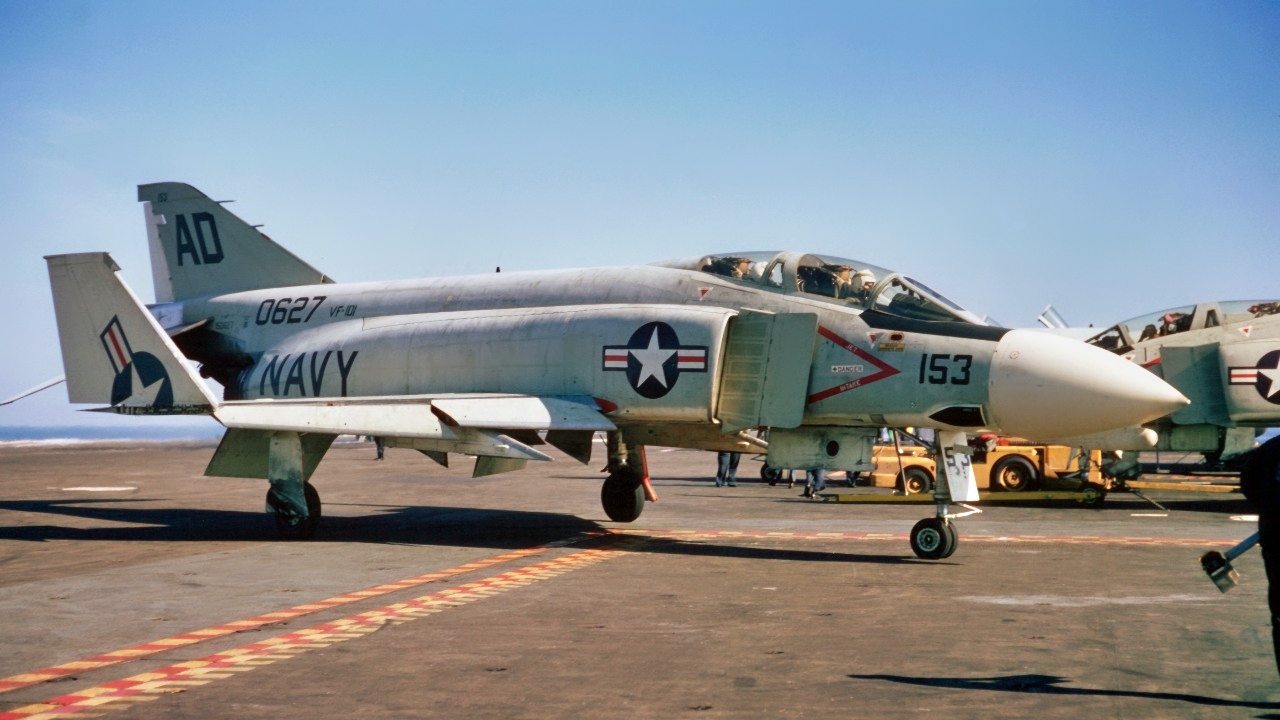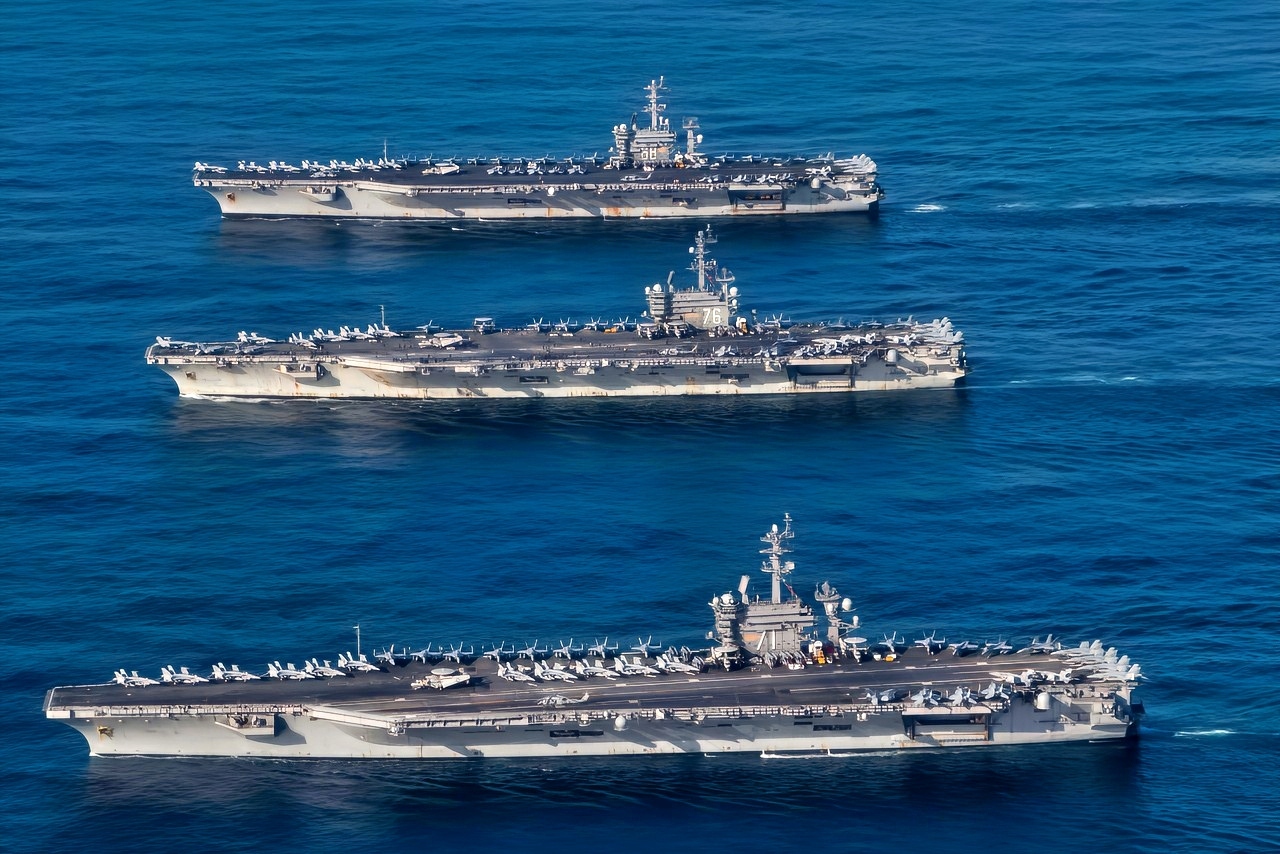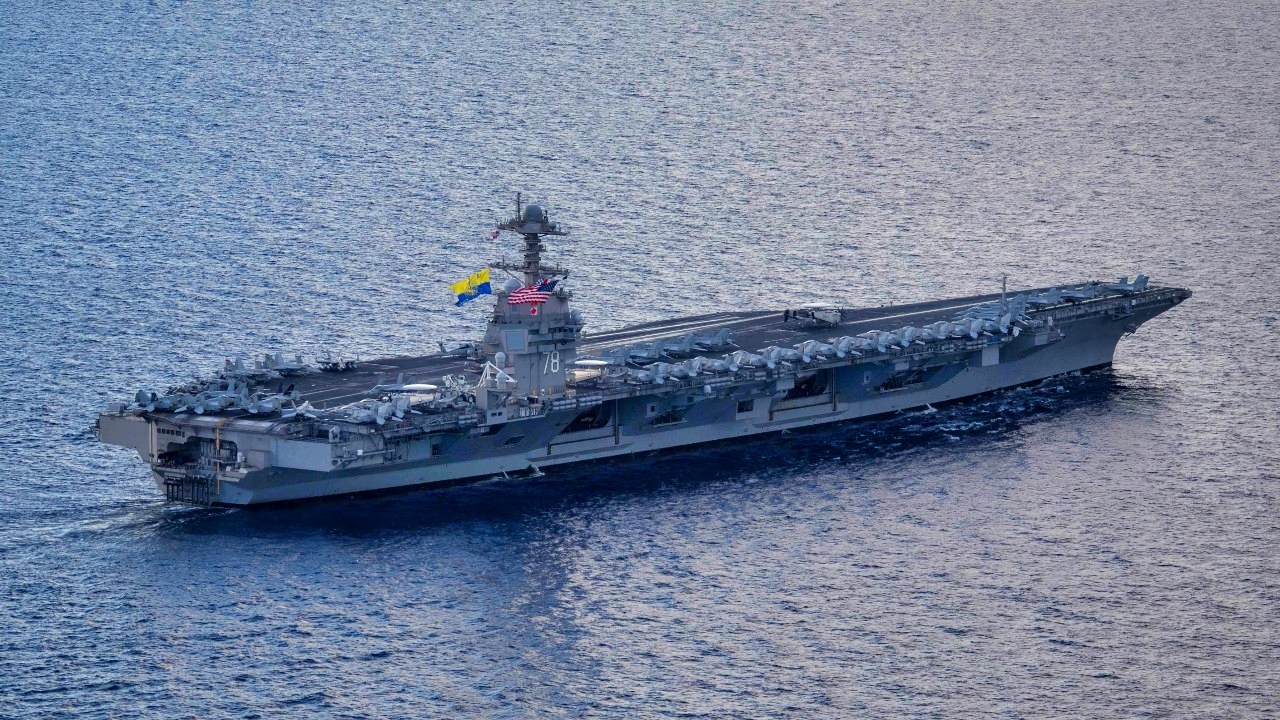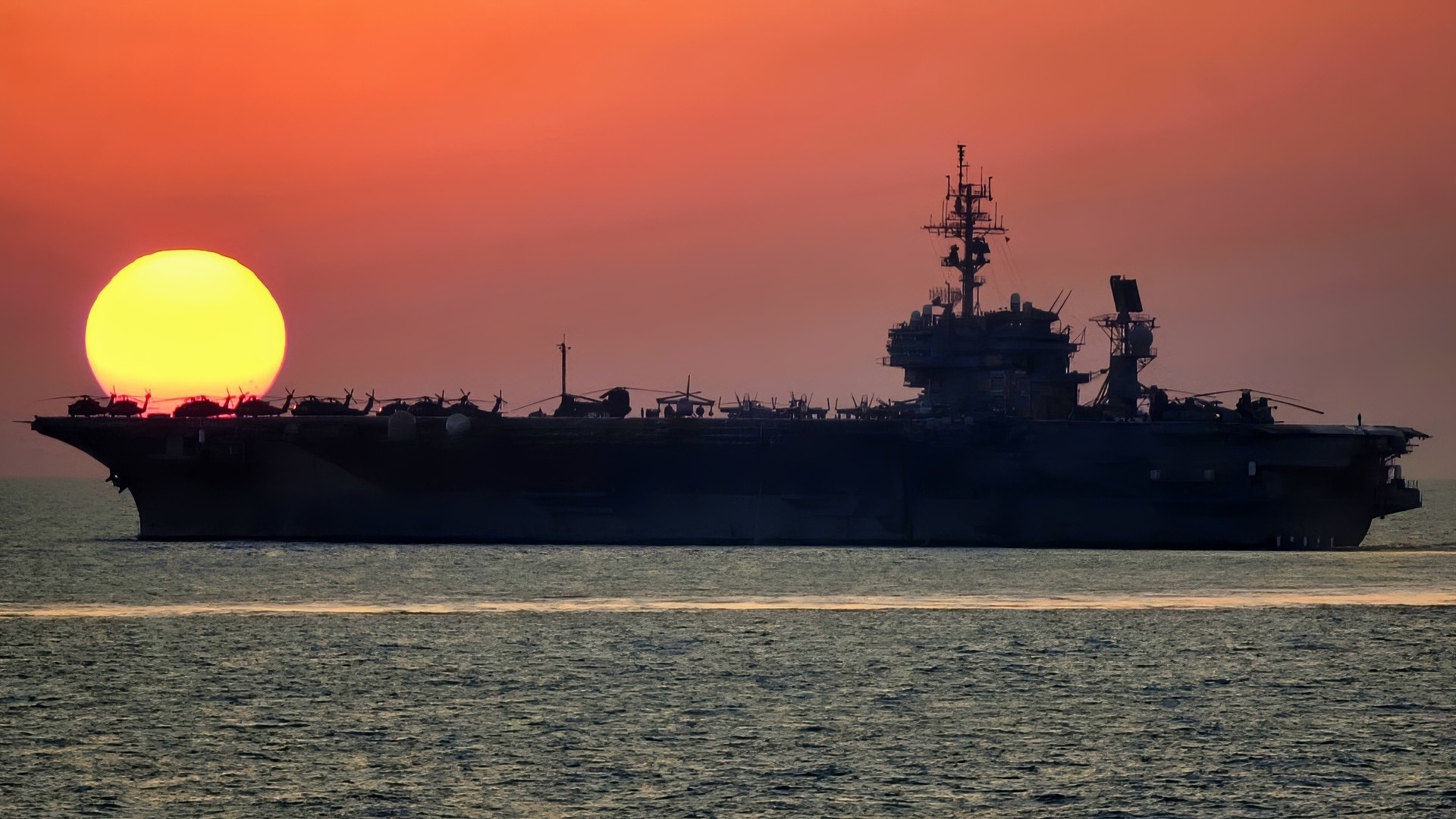Key Points and Summary – The Kitty Hawk-class—USS Kitty Hawk, Constellation, and America—were the Cold War’s quintessential conventional supercarriers.
-Built to generate more sorties than Forrestal-class predecessors, they refined flight-deck flow, packed deeper magazines, and powered heavier jets with four steam catapults.
-From Vietnam’s high-tempo strikes to Libya 1986, Desert Storm, and post-9/11 operations, they delivered persistent sea-based airpower.
-Repeated upgrades added Sparrow, Phalanx, radars, and wiring for Tomcats and Hornets, while mishaps and design limits (oil fuel, manpower, cooling margins) revealed age.
-Retired as Nimitz and Ford classes took over, the Kitty Hawks’ legacy is doctrine and design that shaped every U.S. supercarrier since.
Kitty Hawk–Class Supercarriers: The Conventional Giants That Kept the Cold War In Check
By the late 1950s, Washington faced a Soviet Union fielding long-range bombers, growing submarine forces, and anti-ship missiles designed to challenge U.S. sea control.
Forrestal-class supercarriers had proven the value of big decks and angled runways for heavy jets, but the Navy needed more deck space, more sortie capacity, and better deck-flow to keep pace with the exploding weight and speed of carrier aircraft.
Nuclear propulsion for surface combatants was just arriving; the fleet had only one nuclear carrier in the pipeline. Budgets were finite. What the Navy could afford—and urgently needed—were additional conventionally powered supercarriers that improved on Forrestal without the price and infrastructure penalties of nuclear plants.
Enter the Kitty Hawk–class: large, oil-fired supercarriers optimized for high-tempo jet operations and built to deploy often, stay long, and adapt over decades as air wings transformed from Crusaders and Intruders to Tomcats and Hornets.
In short, they were the Cold War’s practical answer to a strategic math problem: how to put more credible airpower at sea, year after year, without blowing up the shipbuilding plan.
What Made The Design Different: Big Decks, Smarter Flow, Enough Power
The Kitty Hawk hull form looked familiar—single starboard island, long angled deck—but the details mattered:
Flight Deck & Elevators: Compared to Forrestal, the class refined deck-edge elevator placement to reduce taxi conflicts and speed spotting. Two elevators forward of the island plus a portside aft elevator improved the choreography of launch and recovery.
Catapults & Arresting Gear: Four steam catapults and beefed-up jet blast deflectors gave the ships the punch to throw heavier aircraft. Arresting gear and deck structure were hardened for sustained ops with big jets carrying heavy ordnance.
Space & Stores: The class packed deep magazines served by multiple weapons elevators and ample aviation fuel stowage—critical for long line periods in WestPac or the Med.
Sensors & Self-Defense: Over time the carriers moved from earlier gun/terrrier systems to NATO Sea Sparrow, later adding Phalanx CIWS and improved air-search radars (the SPS-48/49 family), plus evolving electronic warfare suites.
Propulsion & Power: Eight high-pressure boilers feeding four geared steam turbines drove the ships beyond 30 knots—fast enough to make wind over the deck—while providing substantial hotel steam and electrical capacity for growing avionics and ship systems.
On paper, the Kitty Hawks were “just” improved Forrestals. In practice, they were bigger, smoother-running flight decks with better internal logistics—exactly what the Navy needed to wring more sorties from the same number of hulls.
Building The Class: Three Sisters (And A Variant)
USS Kitty Hawk (CV-63) commissioned in 1961 and quickly became a Pacific Fleet workhorse.
USS Constellation (CV-64), also 1961, suffered a catastrophic yard fire during construction that killed scores of workers and delayed completion—a sobering reminder of the risks and complexity of building supercarriers.
USS America (CV-66), commissioned 1965, incorporated distinctive tweaks (including early-career sonar fit and anchor changes) and often operated in the Atlantic/Mediterranean.

A Fighter Squadron 101 (VF-101) F-4J Phantom II aircraft taxis on the flight deck of the attack aircraft carrier USS AMERICA (CVA 66).
USS John F. Kennedy (CV-67) followed in 1968 with major differences; many historians treat her as a related but separate class.
For our purposes, the heart of the “Kitty Hawk–class” story is Kitty Hawk, Constellation, and America—three ships that defined conventional supercarrier operations for nearly half a century.
Life At Sea: A Long, Hard Operational History
Vietnam And The High-Tempo Carrier War –
All three core ships took turns at Yankee Station, launching the grinding, day-night cycles that defined the carrier war over Southeast Asia. Constellation rotated frequently to the Gulf of Tonkin and logged heavy strike operations across Rolling Thunder and later Linebacker campaigns. Kitty Hawk’s air wing flew deep-strike and interdiction, close air support around Khe Sanh, and relentless BARCAP and TARCAP missions that kept the air war stitched together. America did multiple Vietnam tours, sometimes spending well over 100 consecutive days on station—proof of the class’s endurance.
The Fleet’s Daily Work: Presence, Crisis Response, Deterrence
After Vietnam, these carriers remained the Navy’s global Swiss Army knives. America made repeated Mediterranean cruises, basing the Sixth Fleet’s airpower in the region’s tight geopolitics. Kitty Hawk pivoted across the Pacific, from Korea contingencies to the North Arabian Sea as crises flared. Carrier decks became a familiar staging ground for refugee rescues, disaster response, maritime surveillance, and the quieter but vital mission of shadowing Soviet patrols.
Libya 1986 And The Return Of Wartime Strikes
In April 1986, as part of a joint U.S. response to state-sponsored terrorism, carriers launched strikes against Libyan targets in Operation El Dorado Canyon. America’s air wing flew from the Med alongside USAF F-111s, demonstrating precision-strike reach from the sea without access to regional bases—exactly the kind of strategic flexibility the class was built to provide.
Desert Storm And The Post-Cold War
During Operations Desert Shield/Desert Storm and later Balkans operations, America again pulled weight—launching strikes from both the Red Sea and the Persian Gulf. In the early 2000s, Constellation deployed for Operation Iraqi Freedom, while Kitty Hawk, then forward-deployed to Japan, served in Operation Enduring Freedom as a flexible staging platform for special operations and fixed-wing sorties. Even in their fourth decade, these ships were still combat-relevant.
Upgrades Over Time: Keeping Pace With A Changing Air Wing
Carriers age, but air wings evolve faster. To stay tactically useful, the Kitty Hawks underwent multiple deep modernizations:
Service Life Extension Program (SLEP): Kitty Hawk and Constellation received major SLEPs that rewired and replumbed the ships, modernized machinery, and upgraded aviation support for F-14 Tomcats, S-3 Vikings, and later F/A-18s.
Combat Systems Refresh: Terrier-era gear yielded to Sea Sparrow and then improved NSSMS, while Phalanx CIWS and better ECM/decoys tightened the self-defense bubble against sea-skimmers.
Deck & Hangar Changes: Larger, hotter aircraft demanded stronger catapults and enlarged jet blast deflectors; weapons elevators and magazines were reorganized for heavier precision munitions.
C4I & Sensors: The ships adopted more capable 3-D air search radars and modern command-and-control suites, knitting them into the growing network of datalinks that fused the air picture across a battle group.
The result wasn’t a brand-new ship—but it felt like one to the crews who returned from SLEP to a quieter, more reliable engineering plant and a flight deck geared for modern aircraft.
Accidents, Mishaps, And Hard Lessons
No long-serving class escapes scars:
Constellation’s Yard Fire (1960): A devastating blaze during construction killed dozens and inflicted massive damage, delaying the carrier’s debut. It triggered tougher fire-safety standards and reinforced how complex and hazardous big-deck building can be.
Racial Unrest Aboard Kitty Hawk (1972): A widely publicized series of fights during a Vietnam deployment forced a Navy-wide reckoning on race relations, leadership, and discipline at sea—an uncomfortable but important chapter in service culture.
Collision At Sea (1984): In the Sea of Japan, Kitty Hawk collided with a Soviet Victor-class submarine during exercises. The carrier suffered minor damage; the submarine fared worse. The episode underscored Cold War proximity risks and the value of cautious seamanship when adversaries shadow each other at night.
Flight-deck operations themselves are inherently dangerous; each ship’s cruise books tell stories of tragic losses and saves that never made headlines. The broader point: the class absorbed punishment, learned, and kept sailing.
Design Challenges And Built-In Limitations
The Kitty Hawks were brilliant for their time, but nothing is free:
Conventional Fueling Tail: Oil-fired plants meant the carriers still needed frequent replenishment, tethering their tempo to the oiler schedule. Nuclear carriers broke that link.
Electrical & Cooling Margins: As sensors and computers grew hungrier, squeezing modern power and HVAC into legacy spaces demanded ingenuity—and sometimes trade-offs.
Manpower: Steam plants and older auxiliaries were maintenance-intensive, driving larger crews and higher life-cycle costs than later designs with more automation.
Protection Architecture: Built decades before today’s anti-ship ballistic missiles and ubiquitous sea-skimmers, the class relied on escorts and layered defenses. Upgrades helped, but the hull form and internal subdivision reflected the design assumptions of the 1950s.
These weren’t fatal flaws—just the limits of a design that had already served two generations of naval aviation.
Kitty Hawk-Class: Why They Were Retired
Three forces retired the Kitty Hawks.
First, age and cost: refueling, reboilering, rewiring, and manning a 1960s-era conventional supercarrier into the 21st century became a budgetary anchor. Second, replacement: the Nimitz-class offered deeper electrical margins, easier logistics, and higher availability; the Ford-class promised still more. Third, diminishing returns: you can refresh combat systems, but you can’t cheaply turn a steam-age hull into a digital-age power-and-cooling platform. America left service in the 1990s; Constellation followed in 2003; Kitty Hawk, the Navy’s last oil-fired carrier and for years its forward-deployed flagship in Japan, decommissioned in 2009. One of the class, ex-America, was later used in a rigorous live-fire test and evaluation that generated invaluable survivability data for future carriers—an unglamorous but fitting final contribution.

The U.S. Navy aircraft carriers USS Nimitz (CVN-68), USS Theodore Roosevelt (CVN-71) and USS Ronald Reagan (CVN-76) underway in the Western Pacific on 12 November 2017. The strike groups were underway and conducting operations in international waters as part of a three-carrier strike force exercise. This was the first time since August 2007 that three U.S. Navy carriers operated together. In 2007, USS Kitty Hawk (CV-63), USS Nimitz (CVN-68) and USS John C. Stennis (CVN-74) participated in exercise “Valiant Shield”.
Combat Record In Brief
Vietnam: High-intensity strike, interdiction, and CAP missions across multiple deployments; the class was central to naval airpower throughout the war.
Cold War Presence: Mediterranean and Western Pacific cruises underpinned crisis response from the Middle East to Korea.
Libya 1986: Carrier-based strikes showcased precision attack from the sea without overflight permissions.
Desert Storm & Balkans: Sustained combat sorties—America notably striking from both the Red Sea and the Gulf—proved legacy decks could still deliver.
Post-9/11: Kitty Hawk’s use as an afloat forward staging base for special operations highlighted the old hull’s remaining flexibility.
No single “signature raid” defines the class; their achievement was decades of reliable power projection.
How They Shaped The Future: The Bridge To Nimitz And Ford
Two legacies stand out.
Operational Legacy: The class institutionalized the big-deck, high-tempo operating model—the choreography of deck handling, the logistics of weapons flow, the rhythms of cyclic flight ops—that still define U.S. carrier aviation. They proved you could sustain that model across decades of changing aircraft and missions.
Design Legacy: In a thousand small ways—elevator placement, deck-edge clearances, magazine flow, catapult integration, command spaces, damage control, hotel services, and personnel arrangements—the Kitty Hawks taught naval architects what to keep and what to change. The Nimitz-class kept the winning flight-deck geometry while using nuclear power to unshackle endurance and electrical growth. The Ford-class then took the next leap in launch and recovery tech, electrical generation, and sortie generation—benefiting from survivability data gleaned during ex-America’s end-of-life tests.
Final Assessment of Kitty Hawk-Class: The Last And Greatest Of The Oil-Burners
If you judge carriers by warhead-on-forehead efficiency, nuclear ships win. If you judge by return on investment across a fraught era, the Kitty Hawk–class holds its own. They were the right ships at the right time: faster to build than nuclear sisters, cheaper to operate than skeptics feared, and adaptable enough to carry naval airpower from Phantom and Skyhawk to Hornet and Tomcat—and into the age of precision weapons.

The world’s largest aircraft carrier USS Gerald R. Ford (CVN 78) sails in the Mediterranean Sea, Dec. 31, 2023. The U.S. maintains forward deployed, ready, and postured forces to deter aggression and support security and stability around the world. (U.S. Navy photo by Mass Communication Specialist 2nd Class Jacob Mattingly)
They were also teachers. Every sortie clocked on their decks, every rust-stained gasket replaced in their steaming plants, every mishap investigated, and every upgrade shoehorned into a tight compartment wrote a lesson that later designers banked. For nearly fifty years, the Kitty Hawks were the indispensable middle chapter between Forrestal’s first supercarrier experiments and the nuclear-powered era that followed.
That’s a legacy any “oil-burner” would envy.
About the Author: Harry J. Kazianis
Harry J. Kazianis (@Grecianformula) is Editor-In-Chief and President of National Security Journal. He was the former Senior Director of National Security Affairs at the Center for the National Interest (CFTNI), a foreign policy think tank founded by Richard Nixon based in Washington, DC. Harry has over a decade of experience in think tanks and national security publishing. His ideas have been published in the NY Times, The Washington Post, The Wall Street Journal, CNN, and many other outlets worldwide. He has held positions at CSIS, the Heritage Foundation, the University of Nottingham, and several other institutions related to national security research and studies. He is the former Executive Editor of the National Interest and the Diplomat. He holds a Master’s degree focusing on international affairs from Harvard University.
More Military
The X-43A Hit Mach 9.6 (And It Was Cancelled?)
The Montana-Class Battleships Have a Message for the U.S. Navy
Russia’s ‘New’ Kirov-Class Battlecrusier Is Like a ‘Death Star’
The U.S. Military’s Big X-44 Manta Stealth Fighter ‘Mistake’ Still Stings
China’s New Fujian Aircraft Carrier Looks Close to Fully Operational










